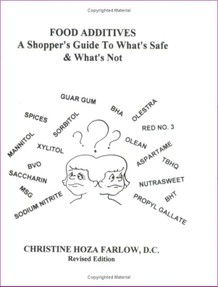 Here is an example of some of the food additives found in food that Christine Hoza Farlow, talks about in her book:
Here is an example of some of the food additives found in food that Christine Hoza Farlow, talks about in her book:
Aspartame, also known as NutraSweet and Equal, breaks down into substances called excititoxins which excite nerve cells in the brain to death. Ninety-two different symptoms from aspartame were reported to the FDA, including headaches, dizziness, seizures, speech and visual impairment, blindness and even death. It can cause symptoms which mimic the symptoms of numerous diseases, including Alzheimer's, epilepsy, chronic fatigue syndrome, depression, multiple sclerosis, Parkinson's, Gulf War Syndrome and mental illness. Even people who don't experience symptoms can suffer long term damage.
Carrageenan, a seaweed derivative often found in "health food" products, is a suspected carcinogen; it may contain hidden MSG.
BHT, legal in the U.S. but banned in England, is associated with liver and kidney damage, behavioral problems, infertility, weakened immune system, birth defects and cancer.
Brominated Vegetable Oil (BVO), an ingredient in a popular sports drink, and pediatric electrolyte replacement beverage is considered unsafe by the FDA, but can still lawfully be used until the FDA takes further action. It is linked to major organ system damage, birth defects and growth problems.
Hydrogenated and Partially Hydrogenated Vegetable Oils, found in most packaged products, are associated with heart disease, breast and colon cancer, atherosclerosis and elevated cholesterol.
MSG, is an excitotoxin which can excite nerve cells in the brain to death. Even people who don't experience reactions from consuming MSG can suffer long term damage. MSG can be hidden in many different ingredients, including broth, hydrolyzed protein, barley malt and whey protein.
Nitrates and Nitrites, powerful cancer-causing agents, are considered dangerous by the FDA, but are not banned because they prevent botulism. These are only a few examples of the many harmful substances legally added to our food.


 Here is an example of some of the food additives found in food that Christine Hoza Farlow, talks about in her book:
Here is an example of some of the food additives found in food that Christine Hoza Farlow, talks about in her book:
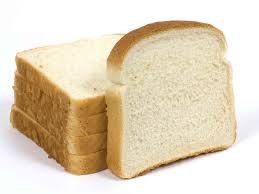 Okay, we all know that processed and fast foods don't have a lot of nutrition but shouldn't the food at least have ingredients we can trust? Listed here is a number of ingredients that may make you gag but it is important to note that if food contains more than five ingredients, has a list of unpronounceable words then maybe it is a good idea to stay away from them and either make the food at home with ingredients you know or buy organic.
Okay, we all know that processed and fast foods don't have a lot of nutrition but shouldn't the food at least have ingredients we can trust? Listed here is a number of ingredients that may make you gag but it is important to note that if food contains more than five ingredients, has a list of unpronounceable words then maybe it is a good idea to stay away from them and either make the food at home with ingredients you know or buy organic.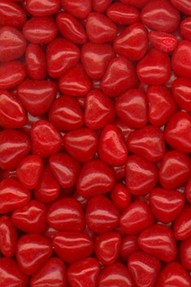 Now this one is really gross! How about beaver anal glands in your candy? This is not a joke. Mostly it is used in the manufacture of perfume and cologne but sometimes it is used to improve the flavor of vanilla, strawberry, raspberry candies and sweets. Commonly called castoreum it has been approved by the Food and Drug Administration as a food additive. The kicker is that sometimes it is just simply referred to as "natural flavoring" in the list of ingredients so you won't have any idea what that means.
Now this one is really gross! How about beaver anal glands in your candy? This is not a joke. Mostly it is used in the manufacture of perfume and cologne but sometimes it is used to improve the flavor of vanilla, strawberry, raspberry candies and sweets. Commonly called castoreum it has been approved by the Food and Drug Administration as a food additive. The kicker is that sometimes it is just simply referred to as "natural flavoring" in the list of ingredients so you won't have any idea what that means.
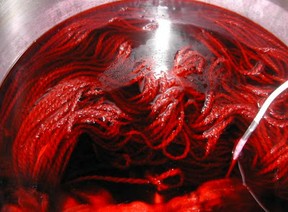 This is one ingredient I have to say that I remember as a kid but I thought it had long ago been removed as a food additive. But apparently not!
This is one ingredient I have to say that I remember as a kid but I thought it had long ago been removed as a food additive. But apparently not!
 Did you ever wonder how they get that shiny coating on candies like skittles or the sprinkles on cupcakes and ice cream sundaes?
Did you ever wonder how they get that shiny coating on candies like skittles or the sprinkles on cupcakes and ice cream sundaes?

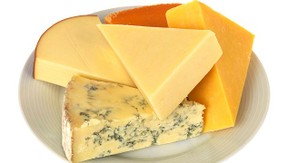 In the United Kingdom, cheese have to be labeled as either suitable or not for vegetarians. No so much anywhere else though.
In the United Kingdom, cheese have to be labeled as either suitable or not for vegetarians. No so much anywhere else though.
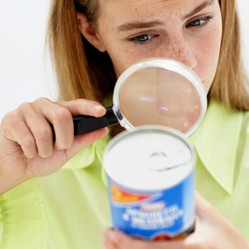

 Ride On Fire Trucks for Kidson 08/23/2014
Ride On Fire Trucks for Kidson 08/23/2014
 Pizza Stones, Tools and Accessorieson 08/22/2014
Pizza Stones, Tools and Accessorieson 08/22/2014
 Communicate with Baby Using Sign Languageon 08/22/2014
Communicate with Baby Using Sign Languageon 08/22/2014
 The Perfect Diaper Bagon 08/22/2014
The Perfect Diaper Bagon 08/22/2014

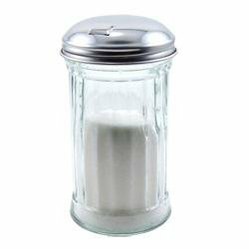
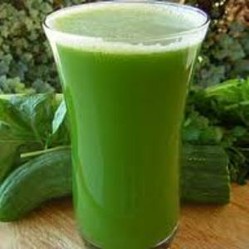
Do You Read Labels Before You Buy Food?
No great fan of processed food here either, but I have to admit to cheating occasionally with microwave rice and pouch sauces.
Thanks for reading my page. I appreciate your comment and I agree. Better to eat food in its original form!
I don't trust the FDA and I stay away from as many processed foods as possible. It's really frightening to think of what we are eating.